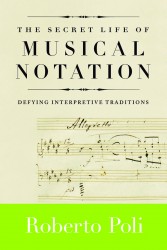 The Secret Life of Musical Notation
The Secret Life of Musical Notation
by Roberto Poli
Amadeus Press
264 pages, illustrations; $24.99 US
• At first, pianist Roberto Poli was simply questioning certain performance directions which he found confusing. How, he wondered, had composers actually intended performers to interpret markings that seemed to either contradict each other, like a hairpin < to pianissimo, or repeat each other, like a hairpin > with decrescendo written underneath.
Poli began to suspect that in the past the hairpins hadn’t been used just to indicate dynamics, as is usually assumed today. In fact, he realized that they could be indicating flexibility in the timing, or the shaping of a melody. With this, he was inspired to re-examine traditional ways of interpreting a number of musical signs, including stretti, pedalling, and sforzandi markings, though for reasons he doesn’t explain he doesn’t look at tempo markings, which, especially in the case of Beethoven, can be equally baffling.
At every step of this fascinating study, Poli has consulted original scores and documents. He has also looked at the instrument the composer wrote for, and the size of the room where the work would have been performed. This is all familiar territory to period instrument players. Yet Poli expresses no inclination to give up his modern piano in favour of an historical instrument. Instead, he advocates more freedom, suggesting that interpretations of composers’ markings have become too rigid during the past century. “Decades of traditions,” he writes, “have been instilling a sense of overexactness in our reading habits – a way of evaluating notation that is remote from how a composer probably imagined it.”
Poli looks at works by composers from Haydn to Prokofiev. But his main focus is on Chopin. As it happens, there’s an exhibit of original scores and letters from Chopin’s time on display at the Royal Ontario Museum. To celebrate Chopin’s 200th birthday, the ROM has pulled out some precious items from its rarely displayed collection of scores and instruments, including a splendid piano made by Pleyel, whose instruments Chopin favoured because of their clear bass register, transparent tone and sensitive action.
Poli’s quest for greater interpretive insight unfolds like the plot of a captivating mystery story. His ideas about what lies behind the notes on the printed page are made all the more persuasive by the many musical examples included in this book. n
Fryderyk Chopin & the Romantic Piano is on view at the Royal Ontario Museum in the Samuel European Galleries until March 27.



